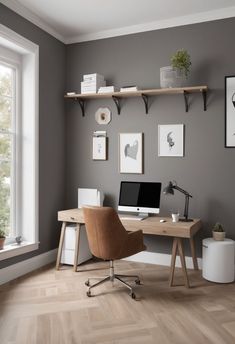The Best Home Office Paint Colors

As remote work becomes increasingly common, creating a productive and inspiring home office space is more important than ever. One of the most impactful ways to transform your workspace is through color. The right paint color can boost productivity, reduce stress, and create a professional atmosphere. Here’s a guide to the best paint colors for your home office, along with their psychological effects and practical considerations.
- Soft Blues
Shades to consider: Sky blue, powder blue, aqua
Psychological effects: Calming, focused, productive
Blue is often associated with clear communication and efficiency. Soft blues can create a sense of tranquility and focus, making them ideal for high-stress work environments. These shades are particularly beneficial for people who need to remain calm under pressure.
Best for: Writers, accountants, and those in high-stress professions
- Energizing Greens
Shades to consider: Sage, mint, olive
Psychological effects: Balanced, refreshing, innovative
Green is known for its balancing and harmonizing effects. It’s associated with nature, growth, and renewal, making it an excellent choice for creative professionals. Lighter greens can brighten a space, while deeper shades add a touch of sophistication.
Best for: Designers, artists, and entrepreneurs
- Warm Neutrals
Shades to consider: Beige, taupe, light gray
Psychological effects: Comforting, versatile, professional
Neutral colors provide a versatile backdrop that won’t compete for attention. They create a sense of warmth and comfort, making your office feel welcoming. These colors are also great for video conferencing, as they provide a professional background.
Best for: Consultants, therapists, and those who frequently video conference
- Crisp Whites
Shades to consider: Pure white, off-white, cream
Psychological effects: Clean, spacious, clear-minded
White creates a blank canvas that can help clear the mind and boost creativity. It reflects light, making small spaces feel larger and brighter. However, be cautious of glare on screens and consider pairing with colorful accents to avoid a sterile feel.
Best for: Minimalists, architects, and those with small office spaces
- Muted Yellows
Shades to consider: Buttercream, pale gold, wheat
Psychological effects: Optimistic, energetic, confident
Yellow is associated with optimism and confidence. Muted yellows can bring warmth and energy to a space without being overwhelming. These shades can be particularly uplifting in offices with little natural light.
Best for: Marketing professionals, sales teams, and creative writers
- Powerful Purples
Shades to consider: Lavender, mauve, plum
Psychological effects: Creative, luxurious, introspective
Purple combines the stability of blue with the energy of red, making it a complex and intriguing color choice. Lighter shades like lavender can be calming, while deeper purples add a sense of luxury and creativity to the space.
Best for: Psychologists, life coaches, and creative professionals
- Energizing Oranges
Shades to consider: Peach, terracotta, coral
Psychological effects: Enthusiastic, sociable, confident
Orange is an energetic and sociable color. Softer shades can create a warm, welcoming atmosphere, while brighter tones can stimulate enthusiasm and creativity. Use orange as an accent color if you find full walls too stimulating.
Best for: Social media managers, public relations professionals, and team leaders
Practical Considerations
When choosing a paint color for your home office, consider the following:
- Lighting: Natural and artificial lighting can significantly affect how a color appears. Test paint samples at different times of day.
- Space size: Lighter colors can make small spaces feel larger, while darker colors can make large spaces feel cozier.
- Existing décor: Consider your furniture, flooring, and accessories when choosing a paint color.
- Personal preference: While color psychology is important, choose a color you enjoy spending time with.
- Accent walls: If you’re hesitant about committing to a bold color, consider painting just one wall as an accent.
Conclusion
The best home office paint color ultimately depends on your personal preferences, work style, and the specific needs of your profession. Don’t be afraid to experiment with different shades and combinations to find what works best for you. Remember, your home office should be a space that inspires productivity and creativity while also reflecting your personal style.



